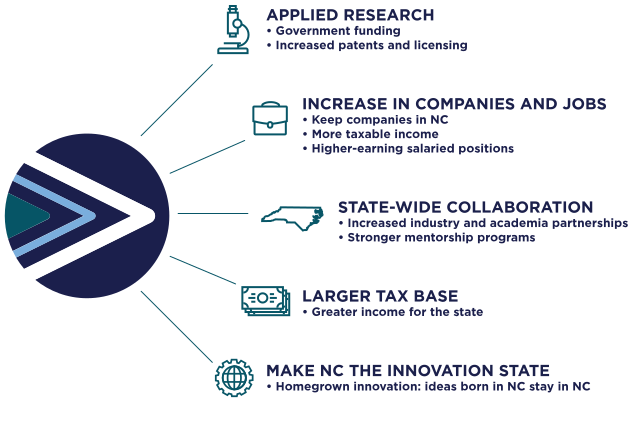Why Invest in Innovation?
Innovation economies realize higher productivity and economic gains. Many economic studies show that public-sector investment in R&D alongside business realize economic and social spillover gains of up to 33x, and those benefits are distributed more broadly.
A well-developed innovation ecosystem delivers both tangible and intangible returns. Of course, successful homegrown companies create jobs, enlarge the tax base, and offer capital returns for any state investments. But a more sophisticated culture of applied research, innovation, and commercialization also brings more touch points between academia, industry, and finance. Over time, this culture and activity hardens into a durable network that attracts attention, capital, and people.

Other States’ Successes with Innovation
Research shows states that invest in innovation and commercialization receive strong tax and employment benefits. Other states increasingly recognize that new products and companies generated from applied research create deep downstream multiplier effects (Enrico Moretti, MIT Sloan Management Review).

Massachusetts
Massachusetts is the undisputed national leader in life sciences innovation and commercialization. Their journey to top billing happened methodically and intentionally. Since 2008, the Massachusetts Life Sciences Center (MLSC), an independent organization, has deployed $1.6 billion in its Boston corridor, the vast majority of it coming from state appropriations. MLSC combines university applied research partnerships with risk capital investments to create a sophisticated regional innovation network.

Ohio
For nearly two decades, Ohio has been at work deploying $2.3 billion in public funds to support applied research, commercialization, and early-stage capital formation. The initiative, called “Ohio Third Frontier,” paired the funding with aggressive policy changes. Legislators passed a new law to permit university faculty to become stakeholders in startups to commercialize their research, and voters amended their state constitution to permit the use of public funds to accelerate commercialized innovation.

Texas
Texas, an economic powerhouse, has been investing in its innovation and commercialization capacity since the 1990s. In the 2000s, the state legislature allocated nearly $1 billion for applied research and commercialization activities, and they haven’t slowed down. In the past several years, Texas has invested hundreds of millions of dollars in a suite of innovation initiatives to develop homegrown technologies and turn them into Texas jobs and companies.

Georgia
In 1990, Georgia business leaders created the Georgia Research Alliance, a 501(c)(3) nonprofit corporation. GRA accelerates university applied research and funds startup commercialization, including through a state-backed venture fund. Georgia lawmakers have allocated $690 million to the nonprofit, which in turn has attracted $11.7 billion in research grants, venture capital, matching funds, and other revenues.

Kentucky
Kentucky just launched a new, state-backed startup fund called “Kentucky Commercialization Ventures.” Combined with existing regional innovation hubs centered around state universities, the fund exists to “transform ideas into services, products, processes, startups, and investments supported by intellectual property.” Kentucky’s model of regional innovation hubs and a commercialization fund works to grow localized innovation networks that connect academia, industry, and capital, ultimately producing commercial ventures from applied research.
At the Speed of Innovation – Will NC Be Left Behind?
North Carolina is a well-recognized leader in research and development. But the outputs of that R&D base don’t measure up to its size. Companies that may have been born in North Carolina move to other states to grow in more sophisticated innovation ecosystems. Failure to nurture an innovation ecosystem withholds benefits from a state or transfers them to other states. And the same multiplier effect applies: one missed opportunity withholds the follow-on jobs and economic benefits that might be created in the future. As the National Commission on Innovation noted in a 2022 report:
Leading innovation hubs, such as Silicon Valley, New York, and Boston, have propelled the United States to become the premier global innovation destination. While these areas continue to produce and benefit from technology breakthroughs, many other regions of the nation are not as fully engaged in the country’s innovation economy.”